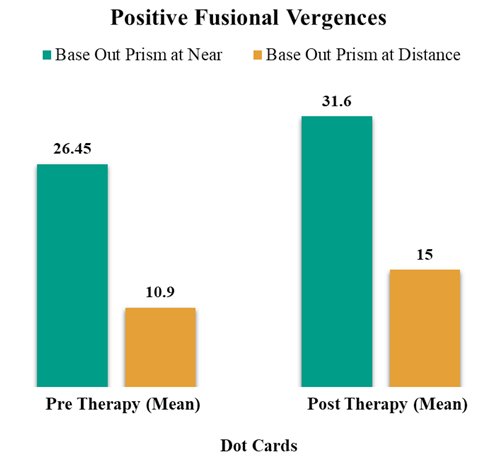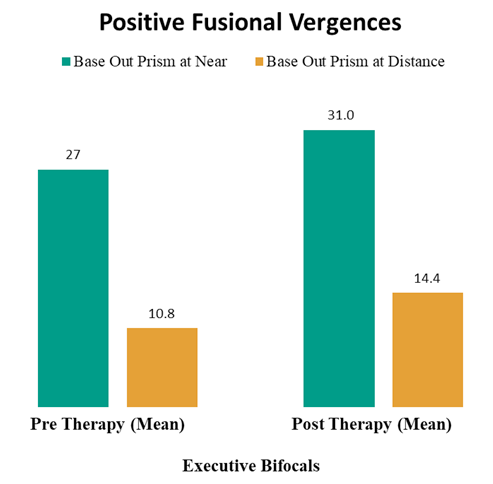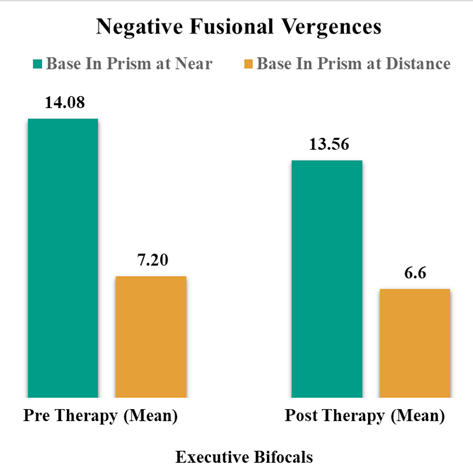Advances in
eISSN: 2377-4290


Research Article Volume 12 Issue 1
1Isra School of Optometry, Isra University, Pakistan
2Department of Optometry, University of Faisalabad, Pakistan
Correspondence: Priyanka Kumari, BS Vision Sciences, M.Phil Optometry , Isra School of Optometry, Isra University, Karachi, Pakistan, Tel 03327824991
Received: February 25, 2022 | Published: March 10, 2022
Citation: Kumari P, Azam S, Abbas S, et al. Effect of vision therapy on fusional vergences in intermittent exotropia. Adv Ophthalmol Vis Syst. 2022;12(1):3-8. DOI: 10.15406/aovs.2022.12.00408
Significance: Intermittent exotropia is intermittently manifest squint at distance and latent exophoria at near. Most of the time, the eyes seems to be aligned with normal binocular single vision is maintained because its exodeviation is intermittently controlled by fusional mechanisms.
Purpose: To evaluate the effect of vision therapy on fusional vergences in intermittent exotropia.
Methods: This hospital-based, Quasi-Experimental study was carried out at the Orthoptics clinic of Al-Ibrahim Eye Hospital from August 2020 to July 2021. Non- probability, purposive sampling was used. This study involved the 40 subjects who were diagnosed with Intermittent Exotropia of age ranges 10 to 25 years, of both genders. A detailed history was evaluated. Orthoptics assessment included visual acuity, cover test, near the point of accommodation and convergence at a distance, and near and fusional vergences of positive and negative with prisms were measured. All subjects underwent vision therapies for 2 months. SPSS version 20.0 was used to analyze the data.
Results: A total of 40 subjects with a mean age of 16.53±2.96 were included in this study. Out of 40 subjects, 22 subjects were females and 18 subjects were males. Subjects who received dot card therapy and executives bifocals therapy showed a significant change in the angle of deviation at distance and near (P=.001), followed by reduced the near point of convergence (P=.001), and increased the positive fusional vergences at distance and near (P=.001). There was no significant improvement seen in near point of accommodation (P=.16) with both therapies. Negative fusional vergences showed non-significant as (near: P=.14, distance: P=.05) with executives bifocals and (P=.26) with dot cards.
Conclusions: This study showed that vision therapies with dot card and executive bifocals therapy have significantly improved the angle of deviation, positive fusional vergences, and near point of convergence in intermittent exotropia subjects.
Intermittent exotropia is the type of squint which is intermittently manifested under the suppression of eyes, and sometimes it’s becomes aligned with a binocular single vision.1 There would be a remarkable difference of 10 prism diopters of the angle of deviation in between the distance and near measurement. Intermittent exotropia usually presents with no symptoms or few as, squinting eyes while looking at the distance, when getting tired, in bad health condition, sick, fatigue less, even after drinking alcohol and closing of one eye in bright light and difficulty to maintain focus while reading.2 The theory behind bright light and squint manifestation is exactly not known but some studies showed that sunlight or bright light affects the fusional vergences as its dazzling light disrupts the fusion.3 Fusion is the superimposition of images from two eyes at the same time. Fusion plays an important role in intermittent squint for maintaining the latent deviation.4 Fusional vergences are based on the motor fusion that a person can maintain the binocular single under a specific amount of vergences. Positive fusional vergences are considered when both eyes converge under normal fusional ranges whereas negative fusional vergences are considered when both eyes diverge under normal ranges.5 Many studies have shown different strategies to overcome the fusional issue but all have seen different results.6 Vision therapies aims to eliminate the suppression, strengthen the fusional vergences of relative convergence, divergence ranges, amplitudes, and improves the angle of deviation.7 Various vision therapies are effective for fusional vergences in intermittent exotropia includes the over minus therapy, dot card therapy, pencil pus-up exercises, broke string, home-based therapies, and office-based accommodative convergence exercises.8,9
A Quasi-Experimental study was carried out at the orthoptics clinic of Al-Ibrahim Eye Hospital, Malir Karachi over the period of 6 months from January to July 2021. The non-probability purposive sampling technique was used. The sample of 40 subjects were included who diagnosed with the intermittent exotropia. 40 subjects were divided into two groups. A group of 20 subjects who were diagnosed with a true type of intermittent exotropia was prescribed Dot card therapy and another group of 20 subjects who were diagnosed with a simulated type of IXT was prescribed with Executives bifocals therapy. All the subjects were given therapies for 2 months. The age ranged from the 10 to 25 years and both the genders were included. Subjects with any previous surgical correction, any deviation of esotropia, hypertropia, hypotropia, constant exotropia, secondary exotropia, consecutive exotropia, and near IXT, neurological strabismus (syndromes and palsies) and any form of amblyopia were excluded. Permission from the ethical committee of The University of Faisalabad was taken for the allowance of data collection in Karachi. Both verbal and written consent was taken from the patients and informed about the given therapies. The detailed information about the study was given to volunteer subjects.
All tests were done at proper distances. Firstly, the Visual acuity of every subject was checked by a logMAR acuity chart at 4 meters of distance. logMAR acuity chart is based on early treatment of diabetic screening which gives the proper acuity of human eyes and removes the chance of error.10 The orthoptics assessment was assessed with different instruments. A cover uncovers test was done by the black plastic opaque occlude at distance 6 m and near 33cm. All the three steps, cover test, uncover test, and the alternate cover test was done on all subjects to distinguish between the type as tropia or phoria and speed of strabismus. The Hirschberg test was used to take an estimation of the angle of deviation in strabismus subjects. A prism cover test was used to measure the degree of ocular misalignment. The deviation was measured by the base in prisms combine with an alternate cover test at both distances of 6m and near 33cm. Prisms were also used to assess the fusional vergences. Both the horizontal and vertical prism bars were used. Fusional convergence of all subjects was checked by base out prism and Fusional Divergence was checked by base in at distance 6 m and near 33cm with fixation target. All the details were collected in a self made proforma. Data were analyzed using SPSS 22 and Paired sample T test was used to check the pre and post proportion of all the variables.
This study included 40 subjects with intermittent distance exotropia. Subjects of age ranged from 10 to 25 years were included in this study. The mean age among subjects was found of 16.53±2.96. There was no specification of gender in this study. Out of 40 subjects, 22 (55%) subjects were females, and 18 (45%) subjects were males. 5 subjects with 12.5% had astigmatism, followed by 4 subjects with 10% had hypermetropia, 27 subjects with 67.5% had myopia, and 4 subjects with 10 % had no refractive error. A total of 20 subjects of the true type of IXT who underwent dot card therapy showed a significant change in positive fusional vergences. All the subjects have shown increased positive fusional vergences range at both distances of 6m and 33cm. A pre-therapy mean of base-out at near was 26.45±1.31 PD and a post-therapy mean was 31.60±1.53 PD with (P=.001). A pre-therapy mean of base-out at distance was 10.90±1.02 PD and a post-therapy mean was 15±1.03 PD with (P=.001) as shown in the Table 1 & Figure 1. There was significant change was seen in negative fusional vergences at near. Subjects improved the negative fusional reserves at near. A pre-therapy mean of base-in at near was 14.70±.98 PD and a post-therapy mean was 12.70±.98 PD with (P=.001). There was no significant change found in negative fusional vergences at distance. A pre-therapy mean of base-in at distance was 7.20±1.01 PD and a post-therapy mean was 6.70±.98 PD with (P=.26) as shown in Table 2 & Figure 2.
|
|
|
Paired Samples test |
|
|
||
|
|
Paired differences |
|
|
|
|
|
|
Mean |
Std. deviation |
Std. Error mean |
t |
Df |
Sig. (2-tailed) |
|
|
Pre-therapy and post therapy base out prism at near |
-5.15 |
1.981 |
0.443 |
-11.627 |
19 |
0.001 |
|
Pre-therapy and post-therapy base out prism at distance |
-4.1 |
1.518 |
0.34 |
-12.076 |
19 |
0.001 |
Table 1 Distribution of effect of dot card vision therapy on positive fusional vergences
Std. Deviation, standard deviation; Std. Error Mean, standard error of the mean; t, t-value; Df, degree of freedom; Sig. (2-tailed), significant difference often referred as P-value
|
|
|
Paired samples test |
|
|
||
|
|
Paired differences |
|
|
|
|
|
|
|
Mean |
Std. deviation |
Std. error mean |
t |
df |
Sig. (2-tailed) |
|
Pre-therapy and post-therapy base in prism at near |
2 |
1.298 |
0.29 |
6.892 |
19 |
0.001 |
|
Pre-therapy and post-therapy base in prism at distance |
0.5 |
1.933 |
0.432 |
1.157 |
19 |
0.262 |
Table 2 Effect of dot card vision therapy on negative fusional vergences
Std. Deviation, standard deviation; Std. Error Mean, standard error of the mean; t, t-value
Df, degree of freedom; Sig. (2-tailed), significant difference often referred as P-value

Figure 1 Distribution of effect of dot card vision therapy on positive fusional vergences.
Dot card therapy is Orthoptic exercise that is useful for enhancing the fusional vergences. The positive fusional vergences can be measured with the prism bar holding the position of base out. The green bar indicates the mean values of pre and post therapy of positive fusional vergences at the distance of 33cm which considered as near. The yellow bar indicates the mean values of pre and post therapy of positive fusional vergences at the distance of 6m. The pre and post proportion at both the distances shows the significant difference which improves the positive fusional vergences.

Figure 2 Distribution of effect of dot card vision therapy on negative fusional vergences.
The negative fusional vergences can be measured with the prism bar holding the position of base in. The green bar indicates the mean values of pre and post therapy of negative fusional vergences at the distance of 33cm which considered as near. The yellow bar indicates the mean values of pre and post therapy of negative fusional vergences at the distance of 6m. The pre and post proportion at both the distances shows the non significant difference of values.
A total of 20 subjects of the simulated type of intermittent exotropia who underwent executive’s bifocals vision therapy showed a significant change in negative fusional vergences. All the subjects have shown increased negative fusional vergences range at both distances of 6m and 33cm. A pre-therapy mean of base-out at near was 27±1.03 PD and a post-therapy mean was 31±1.03 PD with (P=.001). A pre-therapy mean of base-out at distance was 10.8±1.01 PD and a post-therapy mean was 14.4±.82 PD with a (P=.001) as shown in the Table 3 & Figure 3. There was no significant change seen in negative fusional vergences at a distance that underwent executive’s bifocals therapy. Subjects had slightly improved the negative fusional reserves at distance but not significantly. A pre-therapy mean of base-in at distance was 7.20±1.01PD and a post-therapy mean was 6.60±.94 PD with a (P=.05). There was no significant change found in negative fusional vergences at near. A pre-therapy mean of base-in at near was 14.80±1.01PD and a post-therapy mean was 13.56±.92 PD with (P=.14) as shown in the Table 4 & Figure 4.
|
|
|
Paired samples test |
|
|
||
|
|
Paired differences |
|
|
|
|
|
|
|
Mean |
Std. deviation |
Std. Error Mean |
t |
df |
Sig. (2-tailed) |
|
Pre-therapy and post-therapy base out prism at near |
-4 |
0.918 |
0.205 |
-19.494 |
19 |
0.001 |
|
Pre-therapy and post-therapy base out prism at distance |
-3.6 |
0.821 |
0.184 |
-19.615 |
19 |
0.001 |
Table 3 Distribution of effect of executives bifocal vision therapy on positive fusional vergences
Std. Deviation, standard deviation; Std. Error Mean, standard error of the mean; t, t-value
Df, degree of freedom; Sig. (2-tailed), significant difference often referred as P-value

Figure 3 Distribution of effect of executives bifocal vision therapy on positive fusional vergences.
Executives Bifocals is special type of bifocals that consists of two equal portions of seeing the distance and near portion that is useful for enhancing the fusional vergences by relaxing the accommodation. The positive fusional vergences can be measured with the prism bar holding the position of base out. The green bar indicates the mean values of pre and post therapy of positive fusional vergences at the distance of 33cm which considered as near. The yellow bar indicates the mean values of pre and post therapy of positive fusional vergences at the distance of 6m. The pre and post proportion at both the distances shows the significant difference which improves the positive fusional vergences.
|
|
|
|
Paired samples test |
|
||
|
|
|
|
Paired differences |
|
|
|
|
|
Mean |
Std. deviation |
Std. error mean |
t |
df |
Sig. (2-tailed) |
|
Pre-therapy and post-therapy base in prism at distance |
0.6 |
1.314 |
0.294 |
2.042 |
19 |
0.055 |
Table 4 Distribution of effect of executives bifocal vision therapy on negative fusional vergences
Std. Deviation, standard deviation; Std. Error Mean, standard error of the mean; t, t-value
Df, degree of freedom; Sig. (2-tailed), significant difference often referred as P-value

Figure 4 Distribution of effect of executives bifocal vision therapy on negative fusional vergences.
The negative fusional vergences can be measured with the prism bar holding the position of base in. The green bar indicates the mean values of pre and post therapy of negative fusional vergences at the distance of 33cm which considered as near. The yellow bar indicates the mean values of pre and post therapy of negative fusional vergences at the distance of 6m. The pre and post proportion at both the distances shows the non significant difference of values.
Intermittent exotropia is the commonest form of deviation among exodeviation in the population. Subjects with squint have asthenopic symptoms due to its decompensating phoric phase that is under fusion and fusional maintenance is necessary. Fusional vergences provide the information of subjects with exotropia of the ability to maintain the binocular grades under latent and manifest phases. Therefore, fusional vergences can have clinical importance for the evaluation of severity and type of exodeviation. Positive fusional vergences or fusional convergence have reduced ranges.11
A prospective study reported that the improvement was seen in fusional vergences amplitudes of patients with intermittent distance exotropia with reduced convergence reserves at near.4 A study of 6 months of vision therapies and found that there was a decrease in angle of Exo deviation of about 5 prism diopters in all subjects after successful vision therapy. Positive fusional vergences were improved of ranged from 10.6 PD/4.8 PD to 39 PD/33.6 PD at distance and 15.9PD/9.6 PD to 41.8 PD/33.4 PD at near.12
In this current study, positive fusional vergences with dot card therapy have shown a significant change of approximately 5PD with mean results pre-therapy 26.45±1.31 and post-therapy 31.60±1.53 (P=.001) at near. Almost 5PD has improved in the distance also with mean pre-therapy of 10.90±1.02 and post-therapy 15±1.02 (P=.001). Executives bifocal therapy also have shown a significant change of approximately 4PD with mean results pre-therapy 27±1.03 and post-therapy 31±1.03 (P=.001) at near. Almost 4PD has improved in the distance also with mean pre-therapy of 10.80±1.01 and post-therapy 14.4±.82 (P=.001).
Previous literature has shown improvement of fusional vergences and convergence in all types of intermittent exotropia after vision therapies of prism exercises, pencil push-ups, and occlusion therapy.13 Fusional convergences were very low in all subjects.14 Significant improvement in near exophoria and positive fusional vergences was observed with the vision therapies.15,16
A non-significant improvement was seen in negative fusional vergences in exophoria participants after vision therapy of 15.91±4.90 to 14.73 ±4.60 (P=.013).17 Similiar study showed that fusional divergence was not much affected in intermittent exotropia subjects when assessed with prism bars and synoptophore.18
In this current study, the negative fusional vergences were not much improved after therapies. Dot card therapy has shown an only significant change of approximately 2PD with mean results pre-therapy 14.70±.98 and post-therapy 12.70±.98 (P= .001) at near. There was no significant change found at distance with mean pre-therapy of 7.20±1.01 and post-therapy 6.70±.98 (P=.262). There were non-significant results found with executives bifocals with (P=.14) at near and (P=.05) at distance. The negative fusional vergences are responsible for asthenopia symptoms in individuals. These are the divergence that is mainly increased in all types of exodeviations.19
The research report in this study was revealed that subjects who underwent the vision therapies of dot cards and executive bifocals in intermittent exotropia follow-up of 2 months, increased positive fusional vergences at distance and near. The near point of convergence was also enhanced. There was not any remarkable effect found in negative fusional vergences with both the therapies.
Limitations
Recommendations
None.
There are no financial conflicts of interest.
None.

©2022 Kumari, et al. This is an open access article distributed under the terms of the, which permits unrestricted use, distribution, and build upon your work non-commercially.